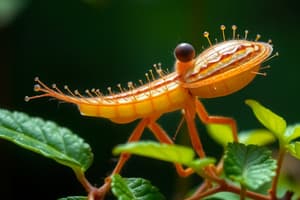Podcast
Questions and Answers
What is the primary function of organs in biological organization?
What is the primary function of organs in biological organization?
Which level of biological organization includes populations of different species?
Which level of biological organization includes populations of different species?
Which of the following is NOT one of the three domains of life diversity?
Which of the following is NOT one of the three domains of life diversity?
What aspect of life forms is modern classification increasingly based on?
What aspect of life forms is modern classification increasingly based on?
Signup and view all the answers
Which level of biological organization represents the combination of all the earth's ecosystems?
Which level of biological organization represents the combination of all the earth's ecosystems?
Signup and view all the answers
What is the primary purpose of homeostasis in living organisms?
What is the primary purpose of homeostasis in living organisms?
Signup and view all the answers
Which of the following best describes the role of adaptation in organisms?
Which of the following best describes the role of adaptation in organisms?
Signup and view all the answers
Which level of biological organization is defined as the basic structural and functional unit of life?
Which level of biological organization is defined as the basic structural and functional unit of life?
Signup and view all the answers
What defines an organelle within a cell?
What defines an organelle within a cell?
Signup and view all the answers
How do living organisms respond to stimuli?
How do living organisms respond to stimuli?
Signup and view all the answers
What is a molecule composed of?
What is a molecule composed of?
Signup and view all the answers
Which of the following ions are commonly regulated within the body's homeostatic mechanisms?
Which of the following ions are commonly regulated within the body's homeostatic mechanisms?
Signup and view all the answers
What is an example of a physiological response to stimuli?
What is an example of a physiological response to stimuli?
Signup and view all the answers
What characteristic distinguishes organisms in the kingdom Animalia?
What characteristic distinguishes organisms in the kingdom Animalia?
Signup and view all the answers
Which of the following best describes the nutritional role of herbivores?
Which of the following best describes the nutritional role of herbivores?
Signup and view all the answers
What is the main function of the scientific method?
What is the main function of the scientific method?
Signup and view all the answers
Which organisms are classified as autotrophs?
Which organisms are classified as autotrophs?
Signup and view all the answers
What type of consumer is classified as a detritivore?
What type of consumer is classified as a detritivore?
Signup and view all the answers
What is the role of the hypothesis in the scientific method?
What is the role of the hypothesis in the scientific method?
Signup and view all the answers
Heterotrophs are primarily characterized by their method of obtaining food. Which of the following statements is true about them?
Heterotrophs are primarily characterized by their method of obtaining food. Which of the following statements is true about them?
Signup and view all the answers
Secondary consumers in an ecosystem mainly include which types of organisms?
Secondary consumers in an ecosystem mainly include which types of organisms?
Signup and view all the answers
What is the main distinction between unicellular and multicellular organisms?
What is the main distinction between unicellular and multicellular organisms?
Signup and view all the answers
Which of the following is NOT a method of asexual reproduction in organisms?
Which of the following is NOT a method of asexual reproduction in organisms?
Signup and view all the answers
What distinguishes the process of 'development' from 'growth' in living organisms?
What distinguishes the process of 'development' from 'growth' in living organisms?
Signup and view all the answers
What is the role of cilia, flagella, and pseudopodia in the context of movement in living organisms?
What is the role of cilia, flagella, and pseudopodia in the context of movement in living organisms?
Signup and view all the answers
Which of the following is the best definition of 'metabolism' in living organisms?
Which of the following is the best definition of 'metabolism' in living organisms?
Signup and view all the answers
Which of the following is a characteristic that distinguishes living organisms from non-living things?
Which of the following is a characteristic that distinguishes living organisms from non-living things?
Signup and view all the answers
Which of the following examples best illustrates the process of 'regeneration' in living organisms?
Which of the following examples best illustrates the process of 'regeneration' in living organisms?
Signup and view all the answers
What is the fundamental unit of life?
What is the fundamental unit of life?
Signup and view all the answers
Which of the following statements is TRUE about Bacteria?
Which of the following statements is TRUE about Bacteria?
Signup and view all the answers
Which of the following is a characteristic shared by bacteria and archaea?
Which of the following is a characteristic shared by bacteria and archaea?
Signup and view all the answers
Which kingdom includes organisms that are mostly unicellular eukaryotes, some multicellular, have cell walls, and include protozoa, eukaryotic algae, and molds?
Which kingdom includes organisms that are mostly unicellular eukaryotes, some multicellular, have cell walls, and include protozoa, eukaryotic algae, and molds?
Signup and view all the answers
Which of the following is NOT a characteristic of fungi?
Which of the following is NOT a characteristic of fungi?
Signup and view all the answers
Which of the following characteristics is SPECIFIC to the kingdom Plantae?
Which of the following characteristics is SPECIFIC to the kingdom Plantae?
Signup and view all the answers
Which of the following is a key difference between bacteria and archaea?
Which of the following is a key difference between bacteria and archaea?
Signup and view all the answers
What is the primary function of meristems in plants?
What is the primary function of meristems in plants?
Signup and view all the answers
Flashcards
Biology
Biology
The study of living organisms and their interactions.
Living vs Non-Living
Living vs Non-Living
Differentiation based on characteristics like growth and reproduction.
Cells
Cells
Basic structural and functional unit of all living organisms.
Unicellular Organisms
Unicellular Organisms
Signup and view all the flashcards
Multicellular Organisms
Multicellular Organisms
Signup and view all the flashcards
Reproduction
Reproduction
Signup and view all the flashcards
Metabolism
Metabolism
Signup and view all the flashcards
Movement
Movement
Signup and view all the flashcards
Homeostasis
Homeostasis
Signup and view all the flashcards
Response to stimuli
Response to stimuli
Signup and view all the flashcards
Adaptation
Adaptation
Signup and view all the flashcards
Atom
Atom
Signup and view all the flashcards
Molecule
Molecule
Signup and view all the flashcards
Organelle
Organelle
Signup and view all the flashcards
Tissue
Tissue
Signup and view all the flashcards
Organ
Organ
Signup and view all the flashcards
Organ System
Organ System
Signup and view all the flashcards
Organism
Organism
Signup and view all the flashcards
Population
Population
Signup and view all the flashcards
Ecosystem
Ecosystem
Signup and view all the flashcards
Bacteria
Bacteria
Signup and view all the flashcards
Binary Fission
Binary Fission
Signup and view all the flashcards
Archaea
Archaea
Signup and view all the flashcards
Eukarya
Eukarya
Signup and view all the flashcards
Protists
Protists
Signup and view all the flashcards
Fungi
Fungi
Signup and view all the flashcards
Plantae
Plantae
Signup and view all the flashcards
Hyphae
Hyphae
Signup and view all the flashcards
Animalia
Animalia
Signup and view all the flashcards
Eukaryotic
Eukaryotic
Signup and view all the flashcards
Heterotrophic
Heterotrophic
Signup and view all the flashcards
Autotrophs
Autotrophs
Signup and view all the flashcards
Detritivores
Detritivores
Signup and view all the flashcards
Hypothesis
Hypothesis
Signup and view all the flashcards
Experiment
Experiment
Signup and view all the flashcards
Ecosystem Levels
Ecosystem Levels
Signup and view all the flashcards
Study Notes
Lecture 2: Characters of Living Organisms
- The lecture covers the characteristics of living organisms, biological organization, and diversity of life.
- Living organisms are distinguished from non-living things by several key characteristics.
Characteristics of Living Organisms
-
Organisms are composed of cells:
- All organisms are composed of basic structural and functional units called cells.
- Organisms can be unicellular (consisting of a single cell, e.g., Protozoa) or multicellular (consisting of many cells, e.g., humans).
-
Growth:
- Means an increase in size and number of cells.
-
Development:
- Includes all changes in an organism from a fertilized egg to an adult individual.
-
Reproduction:
- The ability of an organism to reproduce its kind.
- Reproduction can be either asexual (without fusion of egg and sperm, e.g., binary fission) or sexual (with the fusion of egg and sperm).
-
Movement:
- Most organisms move by various means (e.g., walking, running, swimming, flying).
- Microorganisms move using structures like cilia, flagella, and pseudopodia.
-
Metabolism:
- The sum of all chemical activities within cells and tissues of an organism.
-
Homeostasis:
- The balanced internal state of physical, chemical, and social conditions maintained by living systems (self-regulating control systems).
- Variables like body temperature and fluid balance are kept within specific limits.
- Other variables such as sodium, potassium, and calcium ion concentrations, and blood sugar levels, are also regulated.
-
Responsiveness to stimuli:
- The ability of an organism or its system to detect and respond to changes in its environment (e.g., temperature, light, sound, chemicals) or internal conditions (e.g., hormones, neurotransmitters).
- Examples include reflex actions, movement towards or away from stimuli, and physiological responses like changes in heart rate or hormone secretion.
-
Adaptation:
- The ability of organisms to survive in a particular environment.
Biological Levels of Organization
-
Chemical Level:
- Atoms: The basic building blocks of matter, composed of protons, neutrons, and electrons.
- Molecules: Neutral structures formed by chemically bonded atoms.
-
Cellular Level:
- Organelles: Specialized subunits within cells that perform specific functions (e.g., mitochondria, Golgi bodies, lysosomes).
- Cells: Basic structural and functional units of all living things. They contain cytoplasm and organelles.
- Tissues: Groups of similar cells that work together to carry out specific functions (e.g., epithelial tissue, connective tissue).
-
Organ Level:
- Organs: Structures composed of different tissues working together to perform specific functions (e.g., heart, lungs, liver).
- Organ systems: Teams of organs that work cooperatively to perform broader functions (e.g., digestive system, circulatory system).
-
Organism Level:
- Organisms: Individual living entities capable of carrying out life processes like growth, metabolism, response to stimuli, and reproduction (from single-celled bacteria to complex multicellular organisms like animals and plants).
-
Ecological Levels:
- Population: All individuals of the same species inhabiting a given area.
- Community: Populations of different species that live and interact within a particular area.
- Ecosystem: Community of living organisms and their environment interacting with non-living elements.
- Biosphere: Combination of all ecosystems on Earth.
Diversity of Life
- Scientists classify life into 6 kingdoms (or more recently, 3 domains).
- Key categories include:
- Archaea: prokaryotic, single-celled, often found in extreme environments (e.g. salt lakes, hot springs).
- Bacteria: prokaryotic, single-celled, widespread.
- Eukarya: eukaryotic, includes Kingdom Protista (unicellular and multicellular, heterotrophs and autotrophs), Kingdom Fungi (usually multicellular heterotrophs), Kingdom Plantae (multicellular autotrophs), and Kingdom Animalia (multicellular heterotrophs).
Scientific Method
- A framework for scientific research, including observations, hypothesis formation, experiments, data analysis, and conclusions.
Types of Nutrition in Biology
- Autotrophs: Organisms that produce their own food from raw materials and energy (e.g., plants, algae, certain bacteria).
- Heterotrophs: Organisms that consume other organisms or organic matter for energy and nutrients (e.g., animals, fungi).
- Herbivores: Consume plants.
- Carnivores: Consume animals.
- Omnivores: Consume both plants and animals.
- Detritivores: Consume dead organic matter.
Studying That Suits You
Use AI to generate personalized quizzes and flashcards to suit your learning preferences.
Related Documents
Description
This quiz explores the essential characteristics that distinguish living organisms from non-living entities. It covers topics such as cellular composition, growth, development, reproduction, and movement. Test your knowledge on how these attributes define life and biological diversity.





